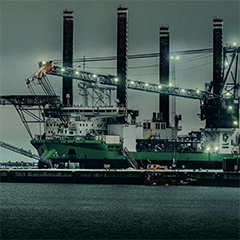Ports are the arrival, transit and exit point for a large part of the world’s trade and can as such be portrayed as economic growth engines. Port activities come with a cost to the environment and the surrounding cities, where our race towards zero carbon emission also affects the way in which ports will be operated in the future. The track record of ports is often centuries long, and their development has been underpinned by the activities in the hinterland as well as the activities of the players in the port.
Future port strategies must include sustainability to ensure a green future and viewed in the context of the lifetime of ports, this becomes increasingly necessary.
The big contributor to carbon emissions
The shipping industry is a big contributor to carbon emission. In its 2017 report on CO2 emission from international shipping DTU, the Technical University of Denmark, stated that 90% of the world’s trade is transported by ship, while 2.2% of all greenhouse gases are emitted by these ships.
There is an environmental argument for the shipping industry to progress towards a greener future, which is also recognized by the International Maritime Organization targeting a 50% reduction by 2050. However, when these ships call into ports close to cities, the need for curbing emissions becomes even more of a priority and results are required much earlier.
A common approach in ports is the provision of shore power, which obviously makes most sense if the power is from renewable resources. This situation juxtaposed with port operation, where various ships call at different quays at all times of the day, makes planning essential, but we know that shore power connection cannot be installed in every possible location in any port.
These are economic conditions for the ports and therefore also towards the shipping industry, where the cost of port calls must not be allowed to increase due to excessive investments in green port infrastructure. This dilemma is on the schedule of many port administrations. This issue is also a preoccupation for the communities surrounding the ports.
In Port Esbjerg, on the west coast of Denmark, has been buying certified green energy from offshore wind parks for half a decade. The green power is used to supply small vessels, buildings and for fueling the port’s fleet of electrical cars. However, this has only decreased the carbon emission by a fraction, when compared to the greenhouse gases from the 6,000 ships calling at the port each year.
To curb the emission, it was imperative to get an overview of the carbon footprint of the port at any one time and to understand where shore power systems could be deployed to maximize the environmental benefit. A live system presenting the carbon footprint of the port at any one given day. The possibility to connect vessels to shore power systems when possible or to deploy these where the largest impact can be assured is optimizing carbon reductions.






























